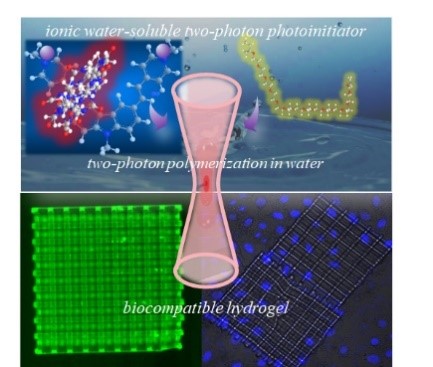Chinese researchers from the Technical Institute of Physics and Chemistry (TIPC) of the Chinese Academy and Sciences (CAS) have proposed a new protocol to enable the green environment-friendly micronano 3D printing of hydrogels in aqueous phase.
Nowadays, the three-dimensional hydrogel (3D hydrogel) is promising to be used in tissue engineering as cell scaffold. And femtosecond laser two-photon polymerization (TPP) as the emerged 3D printing technology has advantages in fabricating precise 3D hydrogel because of its 3D fabrication capability and high processing resolution.
However, it is difficult to fabricate the microstructures in the aqueous solution due to the poor initiating efficiency of photoinitiator and certain cytotoxicity. Therefore, the design and synthesis of water-soluble photoinitiators with large two-photon absorption (TPA) cross-sections are of great significance for expanding the application of TPP in hydrogel processing.
In order to break through the bottleneck of TPA and water solubility of the TPA material, Prof. ZHENG Meiling’s team from the TIPC-CAS has proposed the ionic molecular design idea and strategies to further improve the nonlinear optical property by host-guest chemistry.
The work is published in ACS Applied Material Interfaces.
In the study, the ionic carbazole water-soluble photoinitiator 3,6-Bis[2-(1-methyl-pyridinium)vinyl]-9-methyl-carbazole diiodide (BMVMC) was designed and synthesized to realize the 3D printing in aqueous phase. And the host-guest chemistry reaction is utilized to improve the TPP micro-environment while the hydrophilic cucurbit [7]uril (CB7) and BMVMC are used as the host-guest molecules. The binding ratio of BMVMC and CB7 in the complex was demonstrated as 1:1 both theoretically and experimentally.
According to the research, the TPA cross section of the complex has been enhanced 5 times significantly. Thus, a relatively low laser threshold of 3.7 mW and the resolution of 180 nm were obtained in aqueous phase. Benefiting from the fluorescence property of the photoinitiator, confocal fluorescence images can be recorded without any assistance of fluorescence probes.
Subsequently, the biocompatible 3D engineered hydrogel scaffold microstructure with good mechanical property was achieved in aqueous phase. The proposed protocol would open up new avenues for the material design and prospective application in cell biology and tissue engineering.
This work is supported by the National Key R&D Program, the Natural Science Foundation of China, and the International Partnership Program of Chinese Academy of Sciences.

Figure. Schematic Illustration of the Green Environment-Friendly Micronano 3D printing of Biocompatible Hydrogel using the Ionic Water Soluble Two-photon Photoinitiator (Image by Zheng et al.)
https://doi.org/10.1021/acsami.1c02227
NEWS